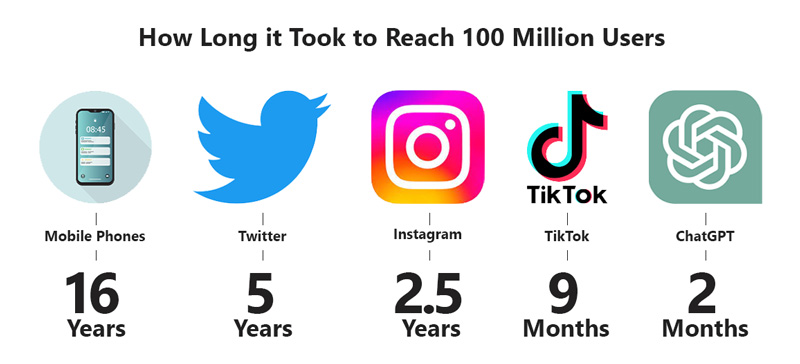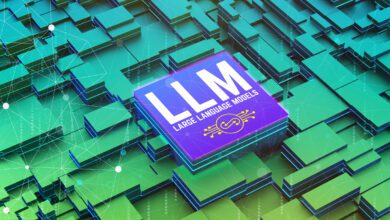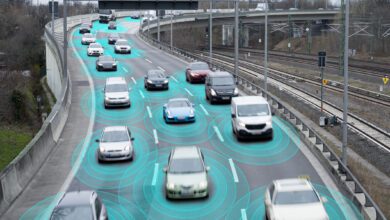
“This powerful technology has the potential to disrupt nearly every industry, promising both competitive advantage and creative destruction.” – Boston Consulting Group
“Generative AI could help a wide swath of people gain the skills to compete with those who have more education and expertise.” – MIT Technology Review
All right, friends, take a breath because the future is here. Generative AI is rapidly becoming a normal part of the way we work. And while this isn’t the AI of science fiction with terminators and robotic warlords, this real-life AI is poised to disrupt every industry. Yes, yours, too. According to Sonya Huang and Pat Grady of Sequoia Capital, “Every industry that requires humans to create original work — from social media to gaming, advertising to architecture, coding to graphic design, product design to law, marketing to sales — is up for reinvention.” This means that understanding the capabilities of AI, including ChatGPT, and their implications for the workplace, is essential for individuals and organizations as we navigate the future of work. So, strap in as we do a quick overview of AI, and what we need to know to benefit our workplaces — before we get left behind.
Embracing the change
In case you are attempting to hide under your desk and wait for the storm to pass… stop that. Let’s stand up and look at the numbers. If we were to just look at ChatGPT, it got 100 million users in just two months. For comparison, it took cell phones (sixteen years), Twitter (five years), Instagram (two and a half years), and TikTok (nine months) to hit the same number of users. Just that one platform of AI is truly taking the world by storm, so it’s time to put on your rain jacket and toughen up, buttercup.

Be part of the disruption
Let’s move on to addressing the elephant.ai in the virtual room — is generative AI going to take your job? The prevalent answer is not necessarily, but someone using AI will. Since it is trained on vast amounts of text data, AI is equipped with an impressive ability to understand context, provide relevant information, and engage in coherent conversations. Its potential to enhance productivity, streamline workflows and foster innovation is reshaping how we approach work. Automation is one of the most significant ways it will change the workplace. Mundane and repetitive tasks that consume valuable time can now be delegated to AI-powered systems. By offloading routine tasks to AI, individuals and organizations can increase productivity and dedicate more attention to critical thinking and complex problem-solving. This is why if we don’t learn to leverage AI, then the person who does leverage it will take our job with all of the time and resources that they have to spare.
Collaborating and augmenting with AI
Now that we have the lay of the land, we can dip our toes into working with AI. Entire seminars go into using AI effectively, but let’s take a brief look at utilizing it for collaboration and augmentation. By collaboration, I mean that it can facilitate efficient knowledge sharing, brainstorming sessions and project coordination. For example, ChatGPT can act as a virtual teammate, providing insights, suggestions and expertise on various subjects. Its ability to engage in meaningful conversations breaks down barriers and promotes inclusivity, irrespective of geographical or cultural differences. This democratization of knowledge and the fostering of cross-functional collaboration will pave the way for innovative solutions and accelerated progress in the workplace. Additionally, AI is not intended to replace human intelligence, but rather to augment it. As a tool, it enhances human capabilities and acts as an intelligent assistant. By leveraging AI’s vast knowledge base, individuals can quickly access information, perform complex calculations and gain insights. This synergy of human and machine intelligence empowers workers to make more informed decisions, solve problems efficiently and explore creative solutions. The potential for AI augmentation ensures that individuals can focus on tasks that require empathy, critical thinking and strategic decision-making, fostering a more fulfilling work experience.
Getting started
All of that collaborating and augmenting may sound great, but it can be tricky to figure out how to get that ball rolling. Fortunately, we are not alone, and there are a plethora of resources to get us started. First, as Synthesia is known as the world’s leading AI video creation platform for enterprises, Kevin Alster, a Synthesia Learning Strategist, has a wealth of information to share in this video. In less than 10 minutes, he provides insights as to why certain prompts are ineffective, how to have ChatGPT “digest” large quantities of information, and more. Additionally, we at IEEE naturally have our own innovators to look to. And here is an IEEE-USA InSight article from Paige Kassalen with some concrete ways that ChatCPT can help you streamline your day for more effective output. It might take a few attempts as we start working with AI, but these are just two of the many resources we can access from organizations like Synthesia and IEEE to assist us along the way.
Understanding AI in the workplace involves adapting to changing job requirements, fostering collaboration between humans and AI systems, and recognizing its role as a tool for augmentation. This is the time to embrace the opportunities AI brings, while also being mindful of its impact on job roles, skills and workplace dynamics. This is a time of dynamic changes, and we will be reaping the good and bad consequences of this revolution for many, many years to come. Once again, engage with purpose and be mindful, my friends.
Opinions expressed in this article are those of the author and not necessarily those of IEEE-USA or IEEE.






